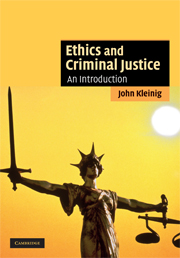2 - Crime and the limits of criminalization
Published online by Cambridge University Press: 05 June 2012
Summary
Actions receive their tincture from the times,
And as they change are virtues made or crimes.
The last chapter offered one possible ethical framework for a criminal justice system, namely, a set of three institutions consisting of a legislature, a judiciary, and various law enforcement operations that reasonable people might be expected to agree to if they were concerned to protect and advance their basic interests or rights. Of course, as with most frameworks, the theory is neater than the practice and the various institutions that actually comprise our criminal justice system do not perfectly exemplify what they profess to be and do.
What makes conduct criminal?
In this chapter we shall briefly turn our attention to the issues of crime and criminalization. Although it is clear that the criminal justice system exists to identify, process, and respond to criminal activity within the community, the initial question we must answer is: What makes activity criminal in the first place? A quick response, based on the social contract theory that we spelled out in the last chapter, might be that activities are criminal if they transgress the laws that govern our social interactions. Because the laws we have are those that we have “agreed” to have imposed on us, those who violate them are properly subject to criminal penalties.
- Type
- Chapter
- Information
- Ethics and Criminal JusticeAn Introduction, pp. 20 - 35Publisher: Cambridge University PressPrint publication year: 2008



